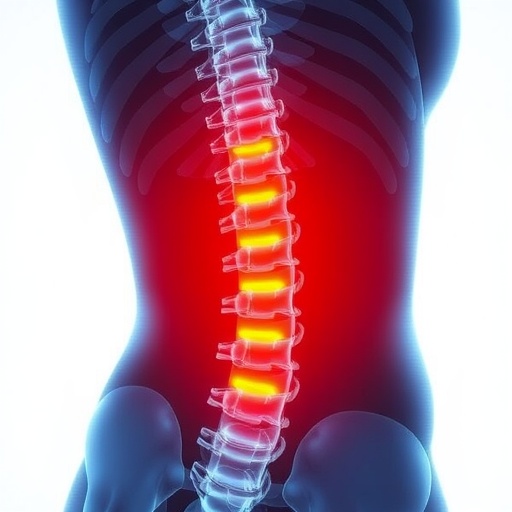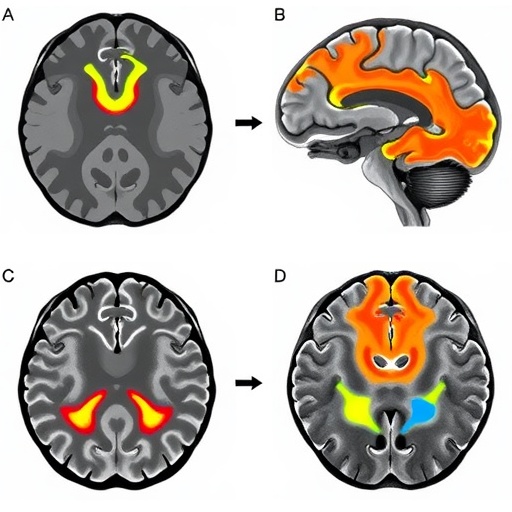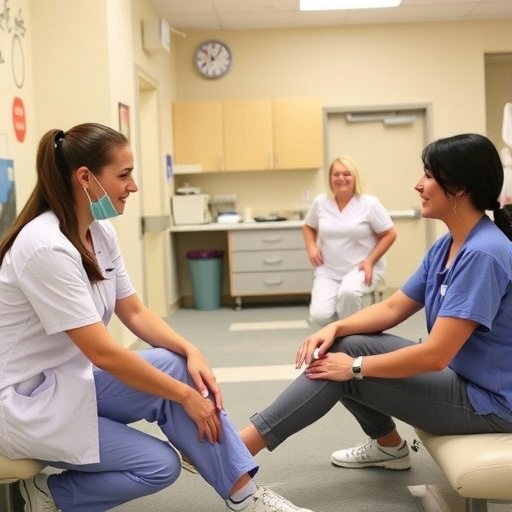Idiopathic scoliosis, a complex spinal deformity characterized by an abnormal curvature of the spine, remains a perplexing condition with elusive origins despite decades of investigation. Emerging research published recently is shaping a transformative understanding of its pathophysiology, centering on a cellular and biomechanical narrative that could revolutionize diagnostics and therapeutics. The groundbreaking study in Nature Communications uncovers the pivotal role of oxidative stress in remodeling intervertebral discs, fundamentally altering their mechanical properties and thereby driving the progression of scoliosis in preclinical models.
At the heart of this investigation lies the intervertebral disc, a crucial fibrocartilaginous structure that cushions vertebrae and allows spinal flexibility. Its integrity is paramount for maintaining spinal alignment. The study elucidates how oxidative stress, a pathological imbalance between pro-oxidant molecules and antioxidants in tissues, catalyzes a cascade of biochemical modifications within disc cells and their extracellular matrix. These changes trigger maladaptive remodeling, manifesting as augmented stiffness—a trait previously speculated but never conclusively demonstrated in scoliosis pathogenesis until now.
Such remodeling fundamentally shifts the biomechanical environment of the spine. Healthy discs permit subtle yet essential deformation under physiological loads, distributing stress evenly along spinal segments. When oxidative stress induces stiffness elevation, the discs lose this capacity, leading to aberrant load transmission. This mechanical derangement synergizes with other factors, culminating in the spine’s progressive and three-dimensional curvature characteristic of idiopathic scoliosis.
The authors deftly leveraged preclinical animal models to simulate this pathological context, employing sophisticated assays to quantify biochemical alterations and mechanical stiffness of intervertebral discs. Their data compellingly links oxidative damage markers to heightened extracellular matrix cross-linking and collagen disorganization. These molecular derangements anchor the microscopic basis for the macroscale biomechanical stiffening observed, bridging a crucial knowledge gap concerning the disease’s etiology.
Importantly, the study delineates a temporal sequence in disc changes, highlighting that oxidative stress initially triggers disc remodeling before gross spinal deformities emerge. This finding reframes idiopathic scoliosis as a disorder initiated at the molecular and tissue level long before clinical detection, advocating for earlier screening and potential interventions targeting oxidative pathways. It invites a paradigm shift from symptomatic treatment to addressing foundational disease mechanisms.
The implications extend into diagnostics, where novel biomarkers reflecting oxidative disc damage could enable early and non-invasive identification of at-risk individuals. By monitoring oxidative stress signatures or matrix remodeling indices in patients, clinicians might predict scoliosis development or progression, personalizing surveillance and therapeutic strategies. This approach promises to mitigate morbidity by forestalling irreversible structural deformities.
On the therapeutic frontier, the research opens avenues for antioxidant-based treatments tailored to spinal tissue. Modulating oxidative stress pharmacologically or through lifestyle interventions might preserve disc elasticity and forestall pathological stiffness. Combined with biomechanical therapies, such strategies could revolutionize scoliosis management, shifting the focus towards maintaining disc homeostasis rather than solely correcting spinal curvature surgically.
Furthermore, understanding the role of oxidative stress enriches the broader field of spinal biomechanics and regenerative medicine. It underscores the intricate interplay between cellular metabolism, extracellular matrix integrity, and tissue mechanics in maintaining musculoskeletal health. These insights resonate beyond scoliosis, potentially informing approaches to other degenerative disc diseases and spine disorders influenced by redox imbalances.
The meticulous methodology, combining histological, biochemical, and biomechanical analyses, strengthens the validity of these conclusions. Demonstrating reproducible disc stiffness elevation and linking it mechanistically to oxidative stress induced matrix remodeling provides a robust framework for future studies. The translational potential is palpable, inspiring multidisciplinary collaborations bridging molecular biology, bioengineering, and clinical orthopedics.
Critically, the study addresses a long-standing enigma: why idiopathic scoliosis predominantly affects otherwise healthy individuals without obvious predisposing factors. It illustrates how subtle oxidative disruptions, possibly stemming from genetic susceptibilities or environmental stressors, can stealthily initiate pathological cascades. This nuanced understanding deconstructs prior simplistic models attributing scoliosis solely to growth abnormalities or mechanical imbalances.
However, several questions remain open for exploration. The precise sources of oxidative stress in the disc microenvironment and their interactions with systemic metabolic pathways invite further research. Additionally, the reversibility of disc remodeling upon oxidative stress mitigation and optimal therapeutic windows warrant detailed investigation. Addressing these aspects will refine intervention timing and efficacy.
In summary, this seminal work revolutionizes the conceptualization of idiopathic scoliosis, spotlighting oxidative stress-induced intervertebral disc stiffening as a key driver of disease pathogenesis. It dismantles previous paradigms centered mainly on mechanical or genetic etiologies, weaving a comprehensive narrative integrating molecular pathology and biomechanics. This holistic model illuminates new diagnostic and therapeutic frontiers, holding promise to transform patient outcomes.
As the field advances, integrating these insights into clinical practice will be crucial. Early detection through oxidative stress biomarkers, coupled with targeted antioxidant therapies, could redefine scoliosis care, emphasizing prevention over correction. Parallel advances in imaging and biomechanical modeling will enrich understanding and personalized intervention design.
Ultimately, the convergence of molecular biology and bioengineering exemplified in this study signals a new era in spine research. It underscores the importance of considering cellular stress responses and tissue mechanics in tandem to unravel complex musculoskeletal disorders. Through such interdisciplinary endeavors, idiopathic scoliosis may transition from a mystifying affliction to a manageable condition with predictable trajectories.
The ripple effects of this research extend beyond scoliosis specialists. It inspires broader scientific curiosity into how oxidative stress influences tissue remodeling and mechanical properties in various systems. Such knowledge could catalyze breakthroughs in aging, fibrosis, and regenerative medicine, showcasing the universal relevance of redox biology in health and disease.
One can envision future studies employing advanced omics technologies to map the oxidative landscape of human discs comprehensively. Combined with patient-derived models and longitudinal clinical data, these approaches will refine risk stratification and treatment personalization. The ultimate goal remains to preserve spinal function and quality of life through early, mechanism-driven interventions.
In conclusion, the elucidation of oxidative stress-mediated intervertebral disc remodeling and increased stiffness as mechanistic underpinnings of idiopathic scoliosis marks a pivotal milestone. This insight enriches foundational understanding, fuels translational research, and promises to reshape clinical paradigms. As these discoveries permeate research and care, they herald a hopeful horizon for patients affected by this enigmatic spine disorder.
Subject of Research: Idiopathic scoliosis pathogenesis and intervertebral disc biomechanics under oxidative stress conditions in preclinical models.
Article Title: Oxidative stress-induced intervertebral disc remodelling and elevated stiffness drive idiopathic scoliosis in preclinical models.
Article References:
Pumputis, P.G., Xu, R., Gopaul, J. et al. Oxidative stress-induced intervertebral disc remodelling and elevated stiffness drive idiopathic scoliosis in preclinical models. Nat Commun 16, 8719 (2025). https://doi.org/10.1038/s41467-025-63742-2
Image Credits: AI Generated
Tags: biochemical changes in spinal discsbiomechanical environment of the spinediagnostics for scoliosisintervertebral disc stiffnessmaladaptive remodeling in spinal healthmechanical properties of intervertebral discsoxidative stress and scoliosispathophysiology of idiopathic scoliosispreclinical models of scoliosisrole of antioxidants in disc healthspinal deformities and their originstherapeutic implications of oxidative stress





